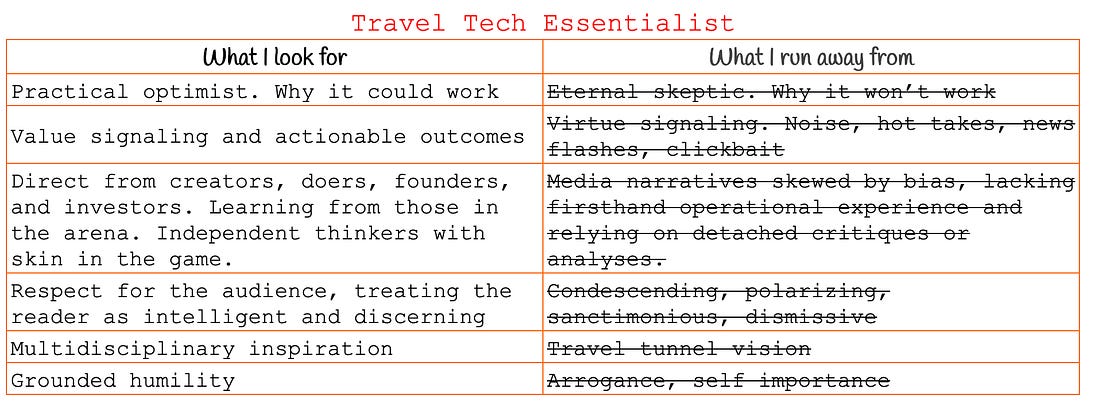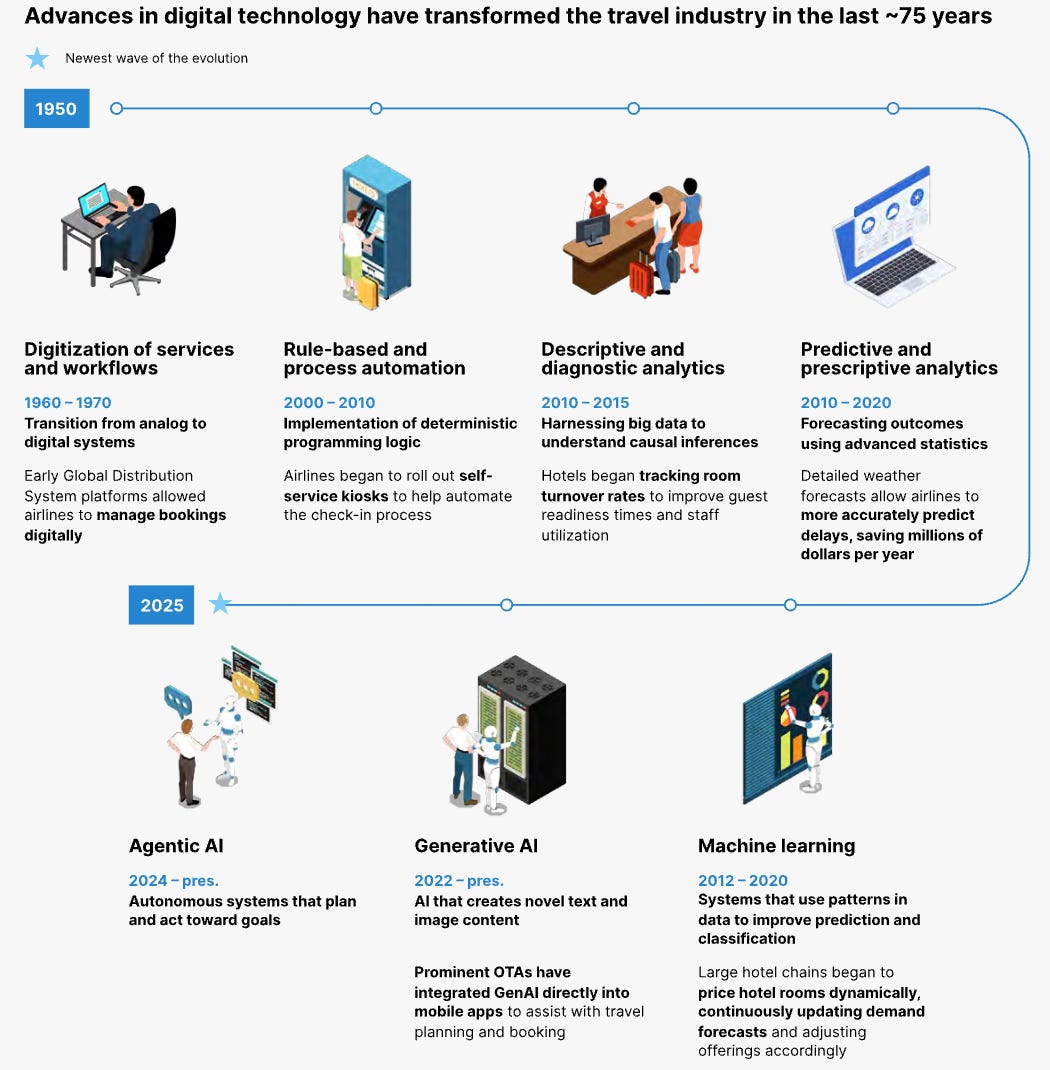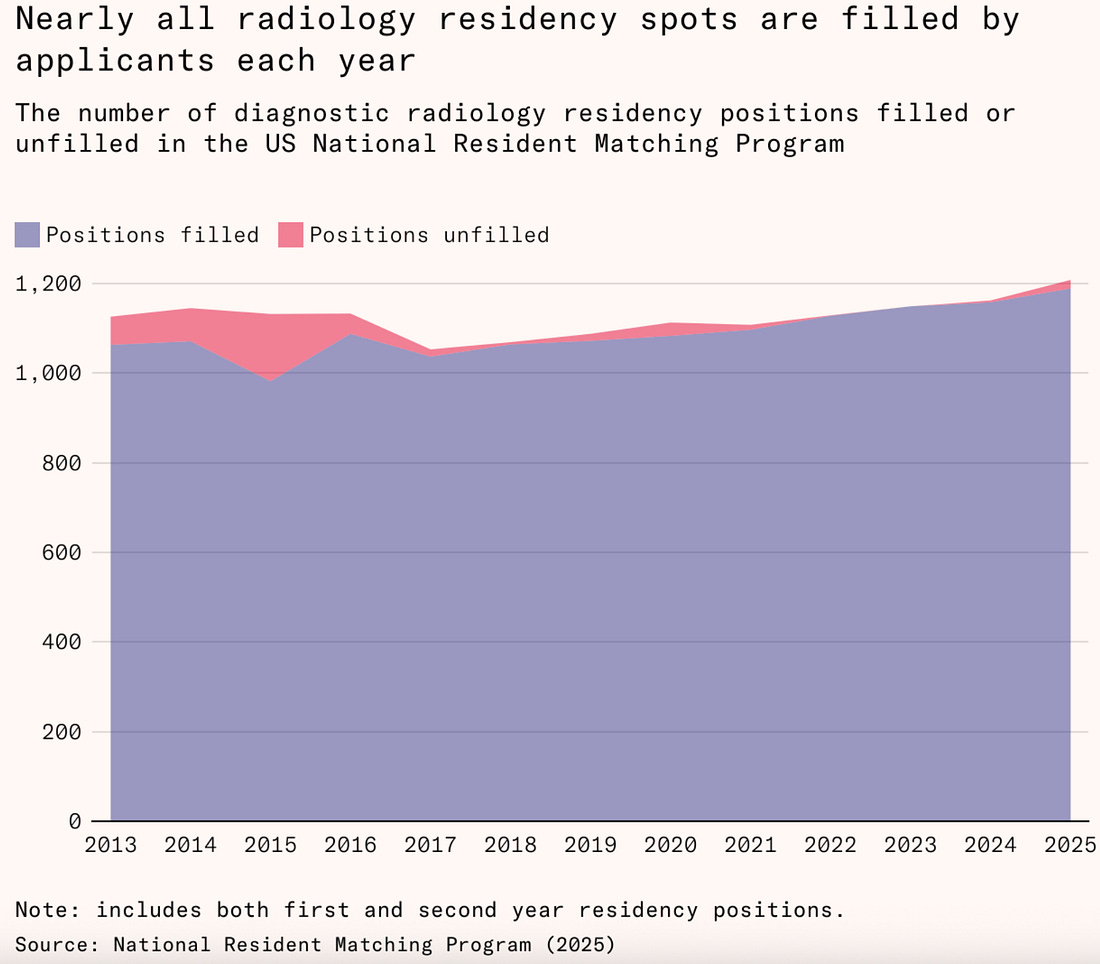Travel Tech Essentialist #185: Compounding
- Mauricio | Travel Tech Essentialist <traveltechessentialist@substack.com>
- Hidden Recipient <hidden@emailshot.io>
Compounding shows up in ways you don’t always measure. A growth loop kicks in. A simple tool quietly brings people in and routes them to the real product. A few words on a button tap into what people actually want. A founder shows up in the final mile and earns trust that lasts. And individual optimism lifts teams and expands what a company is capable of building. I hope you enjoy this issue. Special thanks to Propellic for sponsoring this edition of the newsletter:
1. The modern growth hackerDistribution hacks change every few years. Booking.com perfected SEM. Airbnb growth hacked Craigslist. Zynga rode Facebook’s viral loop. So what’s next? According to a16z’s Speedrun team, it might be clip-farming. A founder hires a swarm of micro-creators → produces hundreds of short-form content variations → the algorithm finds what hits → scale the winners. One team reportedly spent $2k and got over 10 million views in a week, along with thousands of high-intent downloads. It’s working because distribution has shifted from follower-based feeds to algorithmic ones. TikTok, Reels, and Shorts reward what works, rather than who you are. That opens the door for low-cost creators to outperform big-budget campaigns. Like all growth hacks, it won’t last, but this is a window worth testing. Read + 2. Distribution softwareIf clip-farming is the growth hack of the moment, Greg Isenberg argues the next playbook is distribution software. For example, a Chrome extension that hides the cringey motivational posts on LinkedIn and quietly links users to a $49/month developer tool. A salary calculator that goes viral on Reddit and drives 40% of leads to an HR SaaS. An AI selfie-to-Renaissance filter that attracts millions of users and funnels them to an API business underneath. None of these tools are the “real” product, but they become distribution. Now imagine the same approach in travel:
Each one is quick to build, instantly shareable, and quietly routes people back to your core product.
3. Your pitch probably needs more braggingAndrew Chen (a16z) shared a no-nonsense breakdown of what early-stage founders get wrong in their pitches. Here’s a summary of his sharp and tactical advice:
He shared it ahead of Speedrun, a16z’s program for brand-new startups. The deadline for the next cohort is now passed, but applications received now will be considered for the following cohort. They invest up to $1 million and pair you with operator support across GTM, recruiting, capital, and even visa assistance. 4. Optimism as human capitalDan Wang asks whether innovation is “in human nature.” His answer is no: people innovate when they’re inspired, not because it just happens on its own. He argues that innovation comes from imagination and exposure to ideas that push people to create. That makes optimism, imagination, and belief in the future a form of human capital, as real as skills or experience. When you’re hiring, look for people who carry that sense of possibility. Optimists expand what your company can build. Read + Dan Wang This lines up with one of the core principles of this newsletter: practical optimism: 5. Agentic AI: from advice to actionGenerative AI answers questions and agentic AI gets stuff done. A new McKinsey report outlines how travel companies might move beyond pilots and copilots to AI that executes: rebooking flights, assigning rooms, managing pricing, even fixing their own legacy systems. The report is upfront about the challenge that most travel companies aren’t ready to scale agentic AI, and the biggest wins may come from internal workflows first. 6. The final mile is the real testIn his Implications newsletter, Scott Belsky wrote that how you show up in the final mile is what really defines you as a leader. It’s easy to look like a good leader when things are going well. Most of us know how to do the right things when the pressure’s low. But the real test is the final mile, right before a launch, an acquisition, an IPO, or a shutdown. This is the mile where decisions move fast, money shifts, and incentives misalign. It’s also when founders have real power: to shape outcomes, shift equity, protect/benefit the team…or not. As Scott Belsky puts it: do what you want to remember doing 10 years later when you look every team member in the eye (or try to hire them again!). I saw this kind of leadership up close at eDreams through PE exits, restructurings, M&A, the IPO, and everything in between. Massive credit to Javier Pérez-Tenessa for how he navigated those final miles with clarity, integrity, and genuine care for the team. It left a mark on me.
7. Airbnb’s next chapterAt the Goldman Sachs Communacopia + Technology Conference this month, Brian Chesky outlined where Airbnb is headed. His ambition is to take Airbnb from being the Kleenex of vacation rentals to a platform that touches every part of travel and local living. The short version:
8. Winning at AEO (Answer Engine Optimization)SEO is shifting fast. Users are shifting from Google searches to asking LLMs, and getting your product cited within AI answers (“answer engine optimization” or AEO) is the new game. In a recent Lenny’s podcast, Ethan Smith (CEO of Graphite) gives some concrete advice.
9. Why AI could lead to job growthRadiologists have long been the classic example of a job AI was “sure” to wipe out. The logic being that scans are digital, tasks are repeatable and benchmarks are clear, creating the perfect conditions for AI to take over. But as Deena Mousa explains in AI isn’t replacing radiologists, the opposite has happened. AI models can now read scans faster and cheaper than humans, yet demand for radiologists is at record highs. Efficiency lowered the cost of imaging, so hospitals did more of it. The easier and cheaper it became, the more people wanted it. That’s Jevons paradox in action; when productivity goes up, demand expands instead of shrinking. Travel has seen the same dynamic. When low-cost airlines and online booking made flying cheaper and easier, demand exploded. AI planning and personalization could do the same. By lowering the “friction cost” of planning trips, it’s likely to expand the overall travel pie, driving growth in tourism jobs, from advisors to local hosts to on-the-ground experiences. 10. Conversion magic in a buttonGreg Isenberg wrote about how his agency was stuck at 1.5% conversion. The team tried the usual tweaks until a junior designer asked: “What if we’re thinking about our buttons all wrong?” The CTA read “Book a Call.” But nobody wants more calls. They want ideas. So they changed the button to “Request a Brainstorm.” Conversion jumped to 4.2% overnight. A 180% increase from just three words. Same with a high-end coffee subscription. The button said “Subscribe Now.” They changed it to “Unlock Your Coffee Journey,” and subscriptions tripled. The strongest buttons go beyond instructions. They tap into identity and aspiration, showing people who they’ll become. Founders obsess over features and funnels. Sometimes, the next 10x might be hiding in nailing the right words on a button. Travel Tech Essentialist Job Board→ Explore all 1305 open roles on the Travel Tech Essentialist Job Board now.
📩 For monthly updates on the latest roles, subscribe to the Travel Tech Jobs newsletter Raising a round?If you are a startup looking to raise a round (from pre-seed to Series D), I can help (for free). Travel Investor Network is a private platform where I recommend innovative travel startups to investors and innovators. If you’re interested, please start by completing this form. If you like Travel Tech Essentialist, please consider sharing it with your friends or colleagues. If you’re not yet subscribed, join us here: And, as always, thanks for trusting me with your inbox. Mauricio Prieto |
Similar newsletters
There are other similar shared emails that you might be interested in:





